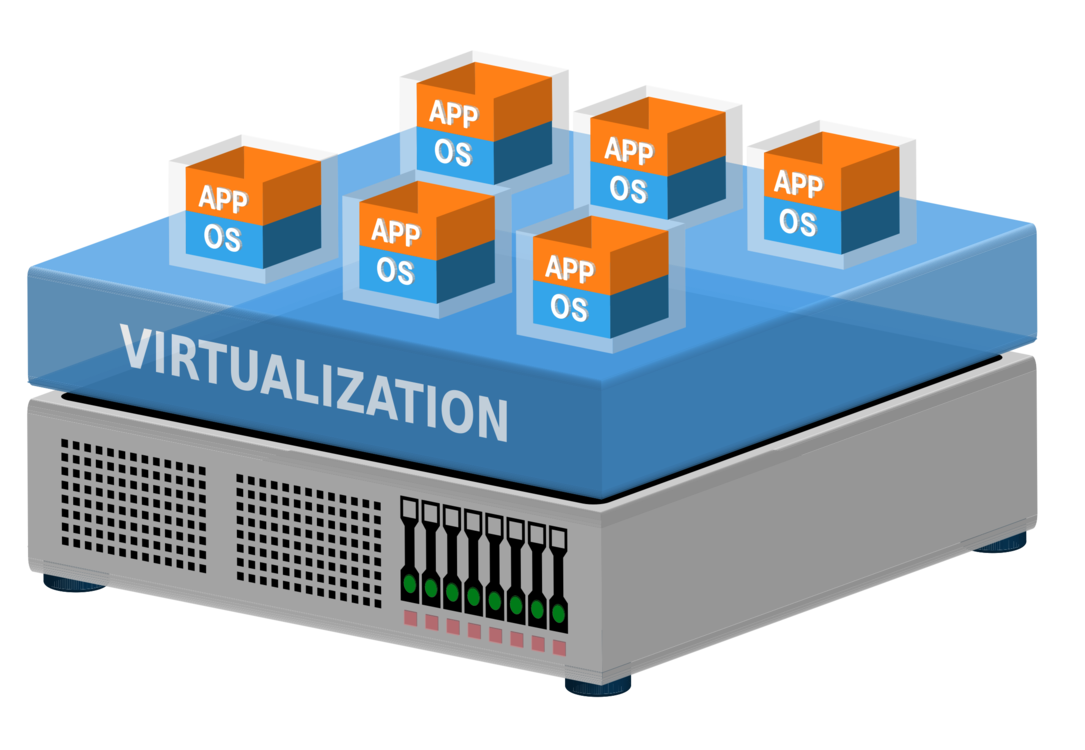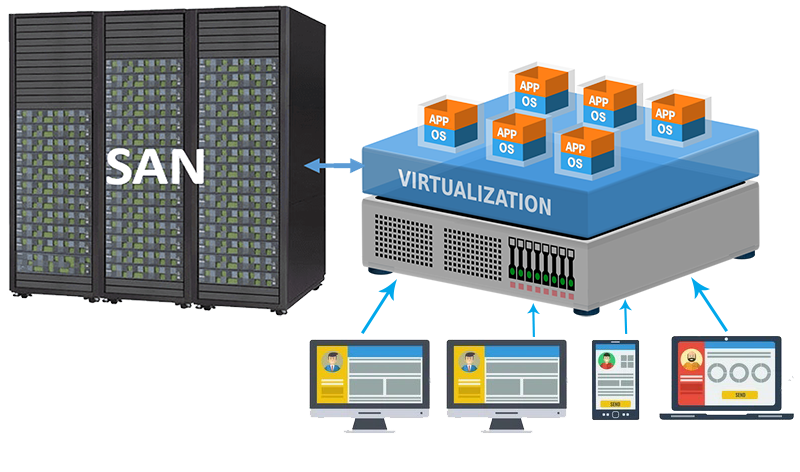- Call Us: (+2) 01092472218
- WhatsApp: (+2) 01098334768
- Email us: info@cloufone.com
- Working Hours: 08:00-16:00
Data Center Computing
VIRTUALIZATION
Virtualization Consists of using a Virtual Machine (VM), which is a tightly isolated software container with an operating system and application inside. Since a virtual machine is completely separate and independent, many can run simultaneously on a single computer. A thin layer of software called a hypervisor decouples the virtual machines from the host. Moreover, the hypervisor dynamically allocates computing resources to each virtual machine as needed.
At Cloufone, we work with some of the most renowned global vendors, namely VMware and Microsoft, to offer the best virtualization solutions to our clients.
VIRTUALIZATION HAS FOUR MAIN BENEFITS:
- Flexibility: Many virtual machines can run simultaneously on one physical server.
- Utilization: Thanks to virtualization, every physical machine is used to its full capacity, leading to a significant cost reduction, as maximum server utilization leads to minimum server count.
- Simplicity: Virtual machines can easily be manipulated with copy and paste ease.
- Security: Due to the isolated nature of virtual servers, websites and applications are more protected with a virtual security that is adaptive, and which protects the virtual machines from malware and attacks as they migrate from host to host

virtualization

Virtualization Consists of using a Virtual Machine (VM), which is a tightly isolated software container with an operating system and application inside. Since a virtual machine is completely separate and independent, many can run simultaneously on a single computer. A thin layer of software called a hypervisor decouples the virtual machines from the host. Moreover, the hypervisor dynamically allocates computing resources to each virtual machine as needed.
At Cloufone, we work with some of the most renowned global vendors, namely VMware and Microsoft, to offer the best virtualization solutions to our clients.
VIRTUALIZATION HAS FOUR MAIN BENEFITS:
- Flexibility: Many virtual machines can run simultaneously on one physical server.
- Utilization: Thanks to virtualization, every physical machine is used to its full capacity, leading to a significant cost reduction, as maximum server utilization leads to minimum server count.
- Simplicity: Virtual machines can easily be manipulated with copy and paste ease.
- Security: Due to the isolated nature of virtual servers, websites and applications are more protected with a virtual security that is adaptive, and which protects the virtual machines from malware and attacks as they migrate from host to host

HYPER CONVERGED
A Hyper Converged Infrastructure (HCI) uses industry-standard servers with local-attached drives to create a highly available and highly scalable software-defined storage at a fraction of the cost of traditional Storage Area Network (SAN) or Network Attached Storage (NAS) arrays. A converged or hyper-converged architecture radically simplifies procurement and deployment.
A Hyper Converged Infrastructure offers unrivaled efficiency and performance thanks to caching and storage tiers, along with the latest hardware innovation like Remote Direct Memory Access (RDMA) networking and Non-Volatile Memory express (NVMe) drives.
With a Hyper Converged Infrastructure, organizations can:
- Reduce Complexity
- Minimize Resource Overhead
- Decrease Costs
This type of infrastructure also offers simplicity, high availability, resource efficiency, manageability, scalability, agility, automation, data protection, flexible deployment and Web scale.
Hyper Converged

A Hyper Converged Infrastructure (HCI) uses industry-standard servers with local-attached drives to create a highly available and highly scalable software-defined storage at a fraction of the cost of traditional Storage Area Network (SAN) or Network Attached Storage (NAS) arrays. A converged or hyper-converged architecture radically simplifies procurement and deployment.
A Hyper Converged Infrastructure offers unrivaled efficiency and performance thanks to caching and storage tiers, along with the latest hardware innovation like Remote Direct Memory Access (RDMA) networking and Non-Volatile Memory express (NVMe) drives.
With a Hyper Converged Infrastructure, organizations can:
- Reduce Complexity
- Minimize Resource Overhead
- Decrease Costs
This type of infrastructure also offers simplicity, high availability, resource efficiency, manageability, scalability, agility, automation, data protection, flexible deployment and Web scale.
VIRTUAL DESKTOP INFRASTRUCTURE (VDI)
Another End-User Management Solution we offer at GRAND ITS is Virtual Desktop Infrastructure (VDI).
A VDI is a virtualization technology that hosts a desktop operating system on a centralized server in a data center.
A VDI is a variation on the client-server computing model, sometimes referred to as server-based computing.
A virtual desktop infrastructure has numerous benefits, including the following:
- Security: Data saved in a VDI remains safe if the laptop used was stolen, as no data will be saved on the machine itself.
- Manageability: A VDI has a minimal number of master images to maintain and secure, which makes it simpler to manage compared to a complete desktop for each user.
- Mobility: A VDI makes it easier to support remote and mobile workers

VIRTUAL DESKTOP INFRASTRUCTURE (VDI)

Another End-User Management Solution we offer at GRAND ITS is Virtual Desktop Infrastructure (VDI).
A VDI is a virtualization technology that hosts a desktop operating system on a centralized server in a data center.
A VDI is a variation on the client-server computing model, sometimes referred to as server-based computing.
A virtual desktop infrastructure has numerous benefits, including the following:
- Security: Data saved in a VDI remains safe if the laptop used was stolen, as no data will be saved on the machine itself.
- Manageability: A VDI has a minimal number of master images to maintain and secure, which makes it simpler to manage compared to a complete desktop for each user.
- Mobility: A VDI makes it easier to support remote and mobile workers
